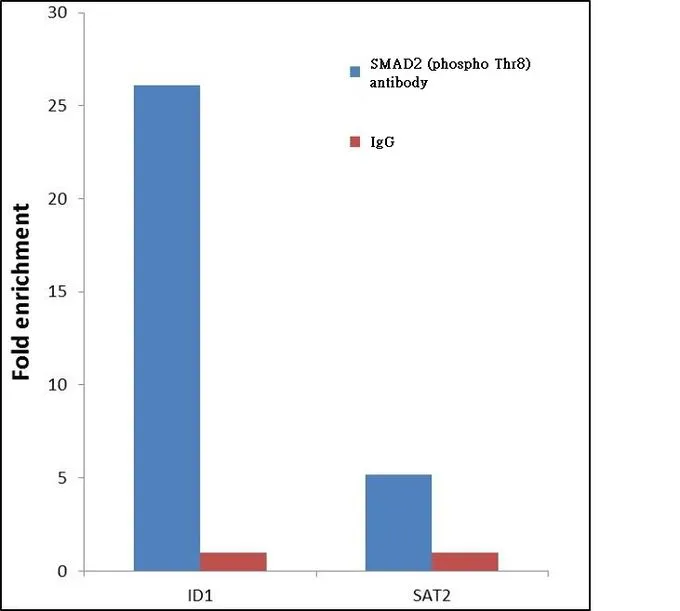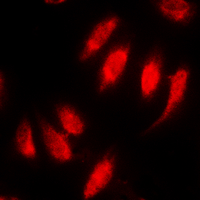SMAD2 antibody
GTX111131
ApplicationsImmunoFluorescence, ImmunoPrecipitation, Western Blot, ChIP Chromatin ImmunoPrecipitation, ImmunoCytoChemistry
Product group Antibodies
TargetSMAD2
Overview
- SupplierGeneTex
- Product NameSMAD2 antibody
- Delivery Days Customer9
- Application Supplier NoteWB: 1:500-1:3000. ICC/IF: 1:100-1:1000. IP: 1:500-1:1000. *Optimal dilutions/concentrations should be determined by the researcher.Not tested in other applications.
- ApplicationsImmunoFluorescence, ImmunoPrecipitation, Western Blot, ChIP Chromatin ImmunoPrecipitation, ImmunoCytoChemistry
- CertificationResearch Use Only
- ClonalityPolyclonal
- Concentration1 mg/ml
- ConjugateUnconjugated
- Gene ID4087
- Target nameSMAD2
- Target descriptionSMAD family member 2
- Target synonymsCHTD8, JV18, JV18-1, LDS6, MADH2, MADR2, hMAD-2, hSMAD2, mothers against decapentaplegic homolog 2, MAD homolog 2, SMAD, mothers against DPP homolog 2, Sma- and Mad-related protein 2, mother against DPP homolog 2
- HostRabbit
- IsotypeIgG
- Protein IDQ15796
- Protein NameMothers against decapentaplegic homolog 2
- Scientific DescriptionThe protein encoded by this gene belongs to the SMAD, a family of proteins similar to the gene products of the Drosophila gene mothers against decapentaplegic (Mad) and the C. elegans gene Sma. SMAD proteins are signal transducers and transcriptional modulators that mediate multiple signaling pathways. This protein mediates the signal of the transforming growth factor (TGF)-beta, and thus regulates multiple cellular processes, such as cell proliferation, apoptosis, and differentiation. This protein is recruited to the TGF-beta receptors through its interaction with the SMAD anchor for receptor activation (SARA) protein. In response to TGF-beta signal, this protein is phosphorylated by the TGF-beta receptors. The phosphorylation induces the dissociation of this protein with SARA and the association with the family member SMAD4. The association with SMAD4 is important for the translocation of this protein into the nucleus, where it binds to target promoters and forms a transcription repressor complex with other cofactors. This protein can also be phosphorylated by activin type 1 receptor kinase, and mediates the signal from the activin. Alternatively spliced transcript variants encoding the same protein have been observed. [provided by RefSeq]
- Storage Instruction-20°C or -80°C,2°C to 8°C
- UNSPSC12352203
References
- Fgf9 inhibition of meiotic differentiation in spermatogonia is mediated by Erk-dependent activation of Nodal-Smad2/3 signaling and is antagonized by Kit Ligand. Tassinari V et al., 2015 Mar 12, Cell Death DisRead more
- The transcription factor GLI1 interacts with SMAD proteins to modulate transforming growth factor beta-induced gene expression in a p300/CREB-binding protein-associated factor (PCAF)-dependent manner. Nye MD et al., 2014 May 30, J Biol ChemRead more




![FACS analysis of HeLa cells using GTX01034 SMAD2 (phospho Ser250) antibody [SD207-1]. Red : primary antibody Black : unlabelled control Dilution : 1:50](https://www.genetex.com/upload/website/prouct_img/normal/GTX01034/GTX01034_20200303_FACS_237_w_23053121_650.webp)
![WB analysis of HEK293T cells transfected with SMAD2 plasmid (Right) or empty vector (Left) for 48 hrs using GTX83612 SMAD2 antibody [2C10]. Loading : 5 ug per lane](https://www.genetex.com/upload/website/prouct_img/normal/GTX83612/GTX83612_3767_WB_w_23061420_337.webp)
![WB analysis of various cell lines using GTX83613 SMAD2 antibody [4G7]. Loading : 35 ug per lane Dilution : 1:200](https://www.genetex.com/upload/website/prouct_img/normal/GTX83613/GTX83613_3688_WB_w_23061420_449.webp)